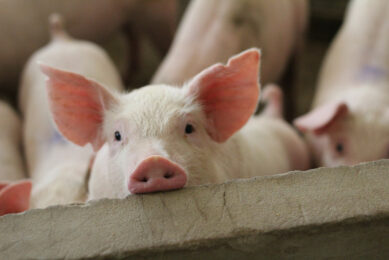Can pellet durability predict delivered fines?

When animals are fed pellets they can eat more and ultimately gain more. Pellets improve the conversion rate of feed to meat, reduce waste, and assure that the intended nutrients are ?consumed with each bite. However, when fines are present in feed, their nutrient content can differ from that of the pellets, known as segregation. How can feed manufacturers become confident that their pellet durability tests are truly predicting feed quality and avoiding the uncertainty that segregation may be occurring in bulk silos?
By Thomas S. Winowiski, technical application manager, Borregaard LignoTech
Segregation can be particularly troublesome when liquids such as fat and enzymes are applied post-pelleting because a higher percentage will be absorbed by the fines. Also, minerals tend to bind poorly to feed and may make up a greater proportion of the fines.
Segregation allows nutrients to un-mix
Nutrient analysis was conducted on coarse and fine particles of a turkey crumble ( Table 1 ). Samples were screened over a No. 30 sieve and the fines were particles less than 600 microns. The result showed a low level of protein in the fines and fat content was high. Calcium and phosphorus were higher in the fines and almost all of the zinc was contained in them.
Although this was a crumble, similar nutrient segregation is expected to happen when pellets contain fines. Not only will the nutrients un-mix in the silo but segregation might also occur through selective eating. The more aggressive birds can consume the majority of the pellets and the late-comers will be left with fines. One way to reduce segregation is to improve pellet durability and thereby reduce the amount of fines.
Pellet durability testing
Durability testing is a good tool for a quality manager, which can provide an estimation of the percentage of pellets that will be delivered to the feeder. The pellet durability test was originally designed to predict the percentage of pellets that would survive through the mechanical handling and transport of pellets to the farm. In today’s world, however, there is some concern that measuring the durability of pellets at the mill may not correlate to the percentage of pellets delivered to the farm. We see companies using only PDI (Pellet Durability Index) data from the mill, and believe that they are feeding good quality pellets on the farm, when in fact they are not. On the other hand, some integrated companies prefer to ignore durability testing entirely and simply collect samples on the farm.
This approach does provide the final answer but it does not help the pellet manufacturer understand how he can affect and improve durability. Therefore it remains important to test pellet durability at the feed mill. To get useful information from pellet quality testing, sampling must be done properly both at the mill, and on the farm.
The challenge of variability
The producer who only tests once per batch will miss quality variations. And the producer who only tests on the farm is powerless to do anything about bad feed that has already been produced. The following example shows how a single sample can give a misleading prediction.
In this case, the production rate and conditioning temperature were constant but amperage and pellet durability varied. Durability of a broiler withdrawal pellet was monitored continuously by testing samples collected off the cooler at three minute intervals. Testing like this can be done manually or with an on-line durability tester. Figure 1 shows that the pellet durabilitie’s ranged between 51 and 68. It was noticed that amperage also varied and that samples with high durability coincided with high amperage. This run was made up of three batches. Nutrient analyses of the samples confirmed that pellets with low durability and made during periods of low amperage also had higher levels of fat. It seems the variable pellet quality was caused by poor mixing. At the feed mill, good quality testing can provide feedback to the producer that tells him when to take action to improve quality.
Correlation
Eleven production runs of turkey pellets were monitored at the pellet mill and farm. In every case three samples were tested for durability at the mill and all of the feed was sacked off from the silo to allow every 10th bag to be sieved. Results from two of these runs are shown in Figure 2 . When pellet durability and delivered pellets were carefully measured there was good correlation between the durability test and delivered fines.
In this study, PDI effectively predicted the proportion of delivered pellets, but it should be noted that the durability was good, and there weren’t many fines present to segregate. For an integrator to understand what is happening in their system, individual production runs must be followed to the field and monitored continuously as the silo unloads. Sometimes labour and bio-security issues can make monitoring delivered pellets humanly challenging. In such cases, a device that could sample feed automatically until the silo is emptied could be used. This sampling need not be routine but should be done often enough to understand how durability at the mill relates to delivered pellets.
Calcium lignosulfonate binder
PDI at the mill can predict the average percentage of pellets that will be delivered, but when pellet quality is poor, PDI testing will miss other on-farm quality problems due to
segregation of fines in the silo.
In the next example turkey finisher pellets were made with 0% and 1% calcium lignosulfonate (CaLS). Conditioning temperature, production rate and amperage remained steady. Three samples from each run were tested for durability. Average results were 77.0 for the control and 86.0 with 1% CaLS. Pellets were transferred into a bulk truck and delivered to two empty farm silos. The silos were emptied into sacks and every 10th sack was screened to measure the percentage of pellets.
On average, control and CaLS treatments delivered 78.7% and 89.7% pellets, very close to the values predicted by the pellet durability test. However, the PDI test of the control pellets did not predict the wide range (60% – 90%) of delivered pellets at the farm that occurred due to segregation during delivery and storage. The feed made with 1% CaLS was more consistent on the farm, containing between 85% and 94% pellets ( Figure 3 ). In this example, regular, on-farm testing revealed variability that could not have been predicted by PDI tests at the mill.
The use of a calcium lignosulfonate binder not only improves the pellet durability when tested at the feed mill, it also helps reduce segregation of fines during handling, transport and storage.
Article featured in All About Feed 21.4 2013












